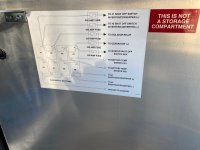EmpirE231
Well-known member
- Aug 12, 2021
- 696
- 557
So this is my new to me motorhome, and I am trying to figure our whether I already have problems with these highline AGM's that are about 2 years old.
first off.... is this considered series or parallel? (this is the diagram on the door)

#2 hard to tell from these pics... but it looks like they are wired up the same way the diagram suggests


which brings me to the main question. First... background of this system.... It has 2 magnum 2000 watt inverters, one dedicated to the residential fridge, and the other to the rest of the "house".... it is supposed to be 4 batteries for the fridge, and 4 for the house..... But to me it looks like all 8 are tied together?? or am I wrong? The issue I'm getting at is how do you set charging parameters for the batteries? since you have 2 inverters trying to charge the entire bank? (I would assume it was supposed to be 1 inverter per set of 4 batteries) Someone fill me in here if I am wayyy of base. I am not familiar with this stuff at all... just trying to figure it out so we can go from there. Thanks.
first off.... is this considered series or parallel? (this is the diagram on the door)

#2 hard to tell from these pics... but it looks like they are wired up the same way the diagram suggests


which brings me to the main question. First... background of this system.... It has 2 magnum 2000 watt inverters, one dedicated to the residential fridge, and the other to the rest of the "house".... it is supposed to be 4 batteries for the fridge, and 4 for the house..... But to me it looks like all 8 are tied together?? or am I wrong? The issue I'm getting at is how do you set charging parameters for the batteries? since you have 2 inverters trying to charge the entire bank? (I would assume it was supposed to be 1 inverter per set of 4 batteries) Someone fill me in here if I am wayyy of base. I am not familiar with this stuff at all... just trying to figure it out so we can go from there. Thanks.

